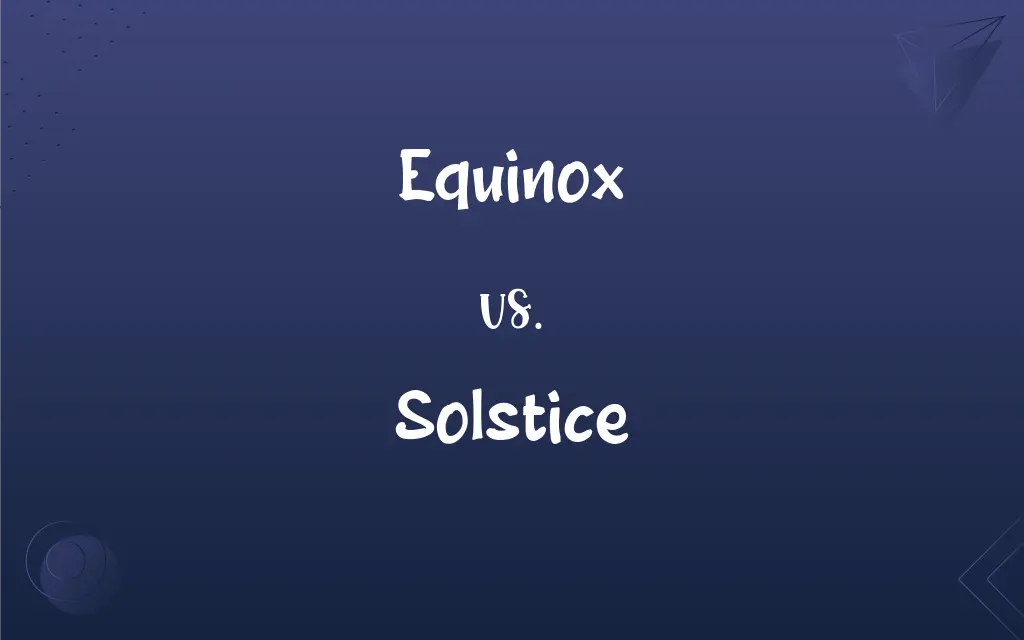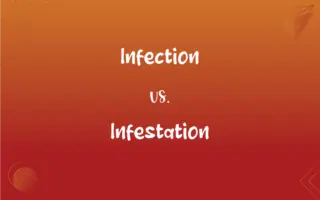Equinox vs. Solstice: What's the Difference?
Edited by Aimie Carlson || By Harlon Moss || Updated on October 17, 2023
Equinox refers to the day when day and night are of equal length, while solstice marks the longest or shortest day of the year.

Key Differences
The earth's tilt and orbit around the sun introduce us to phenomena known as the "equinox" and the "solstice." Equinox, derived from Latin, literally means "equal night." On an equinox, day and night are approximately the same length across the globe. This balance of light happens twice a year: once around March 20th (Vernal equinox) and again around September 22nd (Autumnal equinox).
Solstice, in contrast, stems from Latin words meaning "sun standing still." Solstice represents the points in the year when the tilt of the Earth's axis is most inclined toward or away from the sun. This results in the longest (around June 21st) and the shortest day (around December 21st) of the year. The solstice thus becomes a symbol of seasonal extremes: summer solstice brings the longest day, and winter solstice, the shortest.
While the "equinox" signifies a balance, an equality of day and night, the "solstice" speaks of the sun's peak and trough, of zeniths and nadirs. Both are instrumental in the changing of seasons. The equinox heralds the beginnings of spring and autumn, while solstice ushers in the heart of summer or the depth of winter.
The implications of the equinox and solstice are profound, impacting not just nature but human civilizations for centuries. Equinoxes are celebrated for renewal and balance, while solstices, especially the winter one, have been marked by cultures for the rebirth of the sun. In essence, while equinox paints a picture of equilibrium, solstice tells a tale of solar extremities.
Comparison Chart
Meaning
Day and night are of equal length
Longest or shortest day of the year
ADVERTISEMENT
Occurrence
Twice a year (March and September)
Twice a year (June and December)
Significance
Balance of day and night
Extremities of day length
Seasons Associated
Start of spring and autumn
Peak of summer and winter
Cultural Importance
Symbolizes renewal and balance
Marks solar zeniths and nadirs, celebrated for rebirth
Equinox and Solstice Definitions
Equinox
Equinox is when day and night are roughly equal.
During the equinox, we experience almost 12 hours of daylight and darkness.
ADVERTISEMENT
Solstice
Solstice marks the longest or shortest day.
The summer solstice in June has the longest daylight hours.
Equinox
Equinox occurs twice annually.
The spring equinox marks the beginning of warmer days.
Solstice
Solstice represents solar extremities.
The days surrounding the solstice have the most or least sunlight of the year.
Equinox
Equinox heralds seasonal transitions.
The autumnal equinox signifies the onset of fall.
Solstice
Solstice occurs due to the Earth's tilt.
The winter solstice results from the North Pole tilting away from the sun.
Equinox
Equinox is a global phenomenon.
Everywhere on Earth, the equinox means nearly equal day and night.
Solstice
Solstice happens biannually.
Every December, we experience the winter solstice.
Equinox
Equinox affects the position of the sun.
On the equinox, the sun rises due east and sets due west.
Solstice
Solstice ushers in peak seasons.
The summer solstice heralds the height of the sunny season.
Equinox
Either of two points on the celestial sphere at which the ecliptic intersects the celestial equator.
Solstice
Either of two times of the year when the sun is at its greatest angular distance from the celestial equator. The summer solstice in the Northern Hemisphere occurs about June 21, when the sun is at the zenith on the Tropic of Cancer; the winter solstice occurs about December 21, when the sun is at zenith on the Tropic of Capricorn. The summer solstice is the longest day of the year; the winter solstice is the shortest.
Equinox
Either of the two times during a year when the sun crosses the celestial equator and when the length of day and night are approximately equal; the vernal equinox or the autumnal equinox.
Solstice
One of the two points in the ecliptic at which the sun is furthest from the celestial equator. This corresponds to one of two days in the year when the day is either longest or shortest.
Solstice
A stopping or standing still of the sun.
Solstice
The point in the ecliptic at which the sun is farthest from the equator, north or south, namely, the first point of the sign Cancer and the first point of the sign Capricorn, the former being the summer solstice, latter the winter solstice, in northern latitudes; - so called because the sun then apparently stands still in its northward or southward motion.
Solstice
Either of the two times of the year when the sun is at its greatest distance from the celestial equator
FAQs
How does a "solstice" affect day length?
Solstice marks either the longest or shortest day of the year.
How often does an equinox occur?
Twice a year, around March and September.
When do we experience solstice?
Twice a year, typically around June and December.
What does "equinox" mean?
Equinox is when day and night are approximately of equal length.
Is the winter solstice always the coldest day?
No, it marks the shortest day, but the coldest days often follow it.
Do the Southern and Northern Hemispheres experience equinox simultaneously?
Yes, but they mark opposite seasons.
Are equinox dates fixed?
Generally, but they can vary slightly due to the calendar and leap years.
What celebrations are associated with solstices?
Many, like the Midsummer festivities for the summer solstice and Yule for the winter solstice.
What causes a solstice?
The tilt of the Earth's axis being most inclined toward or away from the sun.
How do equinox and solstice affect our seasons?
Equinox indicates the start of spring and autumn, while solstice marks the peak of summer and winter.
What's the difference in sunlight between equinox and solstice?
Equinox has balanced daylight and night, while solstice has the most or least daylight.
Why is solstice important for astronomers?
It helps understand Earth's axial tilt and its orbit around the sun.
What's the cultural importance of solstice?
Many cultures celebrate it for the rebirth of the sun and its extremities.
Does every place on Earth experience the equinox similarly?
Yes, every location has roughly equal day and night during an equinox.
Can equinoxes help in navigation?
Yes, on the equinox, the sun rises due east and sets due west globally.
Is the day exactly 12 hours long on an equinox?
Almost, but atmospheric refraction can cause slight variations.
When is the day longest: equinox or solstice?
Solstice, specifically the summer solstice.
Why is the equinox significant?
It signifies the balance of day and night and heralds the start of spring or autumn.
Which equinox brings spring in the Northern Hemisphere?
The Vernal equinox around March 20th.
Does the summer solstice mean the earliest sunrise?
Not necessarily, but it does have the longest daylight duration.
About Author
Written by
Harlon MossHarlon is a seasoned quality moderator and accomplished content writer for Difference Wiki. An alumnus of the prestigious University of California, he earned his degree in Computer Science. Leveraging his academic background, Harlon brings a meticulous and informed perspective to his work, ensuring content accuracy and excellence.
Edited by
Aimie CarlsonAimie Carlson, holding a master's degree in English literature, is a fervent English language enthusiast. She lends her writing talents to Difference Wiki, a prominent website that specializes in comparisons, offering readers insightful analyses that both captivate and inform.































































